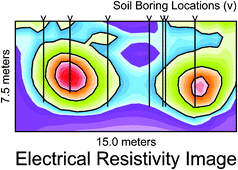Present understanding of the earth’s subsurface is most often derived from samples at discrete points (wells) and interpolations or models that interpret the space between these points. Electrical resistivity imaging techniques have produced an improved capability to map contaminants (especially NAPLs—NonAqueous Phase Liquids) away from traditional wells using actual field data. Electrical resistivity image data, confirmed by drilling, have demonstrated that LNAPL (Light NAPL—less dense than water, such as gasoline) contaminants exist outside of a delineated and remediated area in Golden, Oklahoma. The data also demonstrate that LNAPL exists between monitoring and remediation wells which indicate low contaminant levels when sampled. Additionally, the electrical images provided the drilling location with the highest concentration of hydrocarbon ever found on the site, even after two phases of remediation work had been performed, although the sampling protocols varied. The results indicate that current methods of post-remediation site characterization are inadequate for complete site characterization.

You have access to this article
 Please wait while we load your content...
Something went wrong. Try again?
Please wait while we load your content...
Something went wrong. Try again?


 Please wait while we load your content...
Please wait while we load your content...